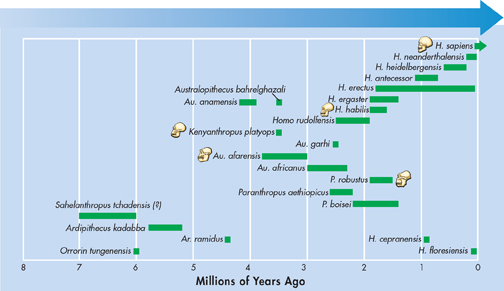VISUAL SUMMARY
HOMININE TIME LINE

FIGURE 26–19 The diagram shows hominine species known from fossils and the time ranges during which each species probably existed. These time ranges may change as paleontologists gather new data. At this writing, several competing hypotheses present different ideas about how these species are related to one another and to Homo sapiens. So far, there is no single, universally accepted hypothesis, so we present these data as a time line, rather than as a cladogram. The fossil record shows that hominine evolution did not proceed along a simple, straight-line transformation of one species into another. Rather, a series of adaptive radiations produced a number of species, several of which display a confusing mix of primitive and modern traits. Interpret Graphs According to this time line, which species in the genus Homo lived at the same time?
The Road to Modern Humans
 What is the current scientific thinking about the genus Homo?
What is the current scientific thinking about the genus Homo?
The hominines discussed so far lived millions of years before modern humans.  Many species in our genus existed before our species, Homo sapiens, appeared. Furthermore, at least three other Homo species existed at the same time as early humans. Paleontologists still do not completely understand the relationships among species in our own genus.
Many species in our genus existed before our species, Homo sapiens, appeared. Furthermore, at least three other Homo species existed at the same time as early humans. Paleontologists still do not completely understand the relationships among species in our own genus.
The Genus Homo About 2 million years ago, a new group of hominine species appeared. Several of these fossils resemble modern human bones enough that they have been classified in the genus Homo. One set of fossils from this time period was found with tools made of stone and bone, so it was named Homo habilis (HAB uh luhs), which means “handy man” in Latin. The earliest fossils that most researchers agree can be definitely assigned to the genus Homo have been called Homo ergaster. H. ergaster was larger than H. habilis and had a bigger brain and downward-facing nostrils that resemble those of modern humans. Homo rudolfensis appeared before H. ergaster, but some researchers choose to classify it in the genus Australopithecus instead of Homo.
Out of Africa—But When and Who? Researchers agree that our genus originated in Africa and migrated from there to populate the world. But many questions remain. When did hominines first leave Africa? Did more than one species make the trip? Which of those species were human ancestors and which were merely relatives? You can see some of the current hypotheses in Figure 26–20.

Table of Contents
- Formulas and Equations
- Applying Formulas and Equations
- Mean, Median, and Mode
- Estimation
- Using Measurements in Calculations
- Effects of Measurement Errors
- Accuracy
- Precision
- Comparing Accuracy and Precision
- Significant Figures
- Calculating With Significant Figures
- Scientific Notation
- Calculating With Scientific Notation
- Dimensional Analysis
- Applying Dimensional Analysis




